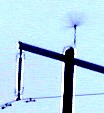|
"You cannot predict it,
A South African entrepreneurial engineering company believed they came up with a novel way (using a similar technique) of protecting people on exposed high ground, in this case a golf course. A tent with such 'ionising brushes' was erected and the first time a storm brewed, the lightning struck all around - but not the tent. The second time yielded the same results and everyone who had been protected from the lightning hailed this as a breakthrough! The third time the structure was trusted to protect left many dead, well into double figures, and the remainder nursing injuries with most being critical. The company forgot the golden rule of lightning - if it has just travelled a few thousand feet, it is not going to worry about the last few feet of attempted insulation. The message is simple; Do not try this at home, it just doesn't work. The reason I included this was to show just what it is we're dealing with. I am not shy to admit that I cried when I read this story. What is fortunate, however, is that it is not all doom and gloom. A lot of research has been done (including yours truly who has been found watching lightning hit arrestor rods!). There is now an additional statement about lightning, The potentially damaging effects of lightning There are many who don't believe this either! In this regard I've been fortunate enough to come from a country where high level static discharges were the order of the day. Although I would never (purely on principle) call myself an expert, let's just say that we've been personally involved in stopping such effects for many years. One site to date has survived an average of 12 strikes for 12 years, and no damage. Proof enough! I just have to laugh at those who insist, when it comes to lightning, to baffle one with science. They start with things like "there is first the up stroke, followed by the down stroke,...." (other words used are 'leaders' and 'streamers'). Yip, you guessed it, these are those who like to refer to themselves as 'experts'. I was blessed with being able to discuss lightning with a true expert (a person who wrote his doctorate in lightning!). This chap used to track lightning. With all his fancy equipment, there was only one part of the lightning sequence he was worried about - the so called "power stroke". Anything else was of no consequence. During my own research I found the same. There was only one distinct blip on the oscilloscope trace - and it is this blip that causes grief when it reaches sensitive equipment. There are two main means by which lightning manifests itself on the power network. This is either by direct contact (lightning hitting power lines), or by direct or indirect induction (the electro/magnetic field generated by the lightning is absorbed by wiring). Both means yield a similar result being a short-term disturbance superimposed on the primary waveform (i.e. 'spike' or 'transient'). This effectively allows all lightning created disturbances to be treated the same. The means by which such disturbances cause damage is again relatively simple. The first is nothing more than the components being asked to conduct the energy of the disturbance. A primary example is if the disturbance happened on the peak of a waveform, and added to the peak voltage, then any diodes conducting at the time would have to bear the brunt of the extra current that would flow under this condition. This goes for most semiconductors found in this condition. The second way damage occurs is when the circuitry (regardless of what it is) is charged up by the now available extra voltage. If this voltage should exceed any isolation barrier then this charged energy is suddenly dissipated via the point of breakdown. If the components are rather 'beefy' then little or no damage occurs. However, any weakness is soon exploited by this sudden release of energy and permanent scaring takes place. The little known aspect of transients is the power intensity may not be high because the time duration is extremely short. However, when the voltage reaches breakdown point, this then opens up an ionised path for serious current flow from example Phase to Earth. The 'damaging' energy is therefore not the lightning induced transient which causes the breakdown, but the power available across the two points that can now flow which would otherwise be separated. This is more common than realized and often overlooked when investigating such "follow-on" effects. The usual problem is the waveform capture on inferior instruments (low sampling rates) shows the high drawing of current leading to a sag in voltage thus causing the deduction that the fault is internal to the site, when in actual fact the problem is an external one. More on this later in "Interpreting the Readings". Accidental Arcing (Tracking) >>
© 06.12.02 |
 CAUSES:
CAUSES: There are those who will try to tell you otherwise, and they will always be proven wrong, sometimes with disastrous consequences. One fallacy is that it can be 'diverted' or 'repelled' away from a sensitive location. The picture shown is of a "wire brush" arrangement on top of a pylon. The idea is it builds up an ion cloud and the lightning 'sees' this as a high impedance point and would rather strike elsewhere.
There are those who will try to tell you otherwise, and they will always be proven wrong, sometimes with disastrous consequences. One fallacy is that it can be 'diverted' or 'repelled' away from a sensitive location. The picture shown is of a "wire brush" arrangement on top of a pylon. The idea is it builds up an ion cloud and the lightning 'sees' this as a high impedance point and would rather strike elsewhere.